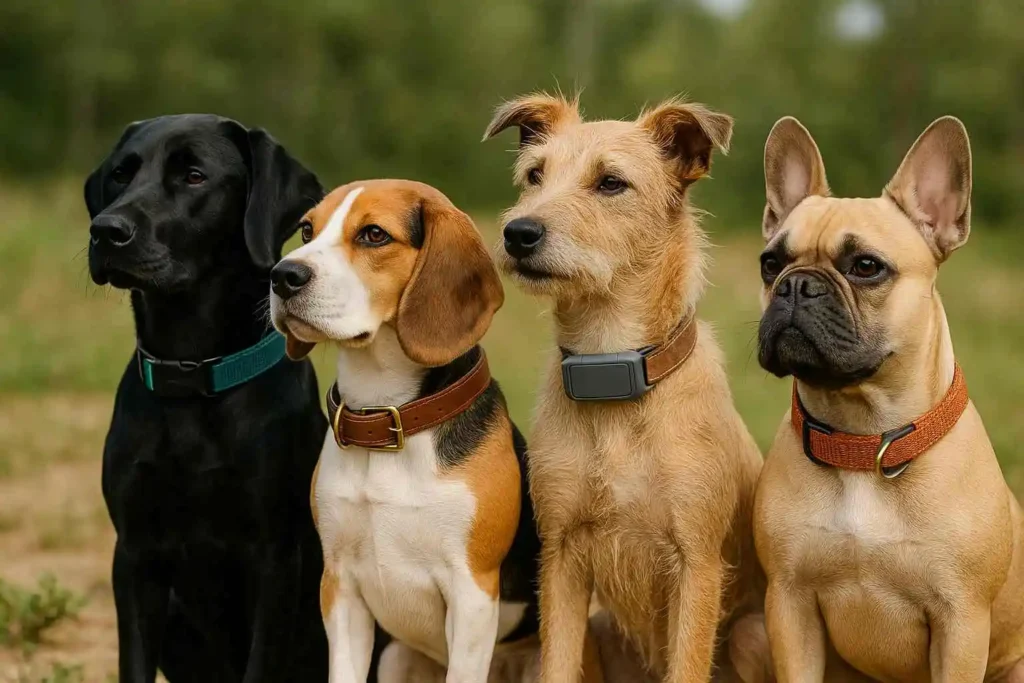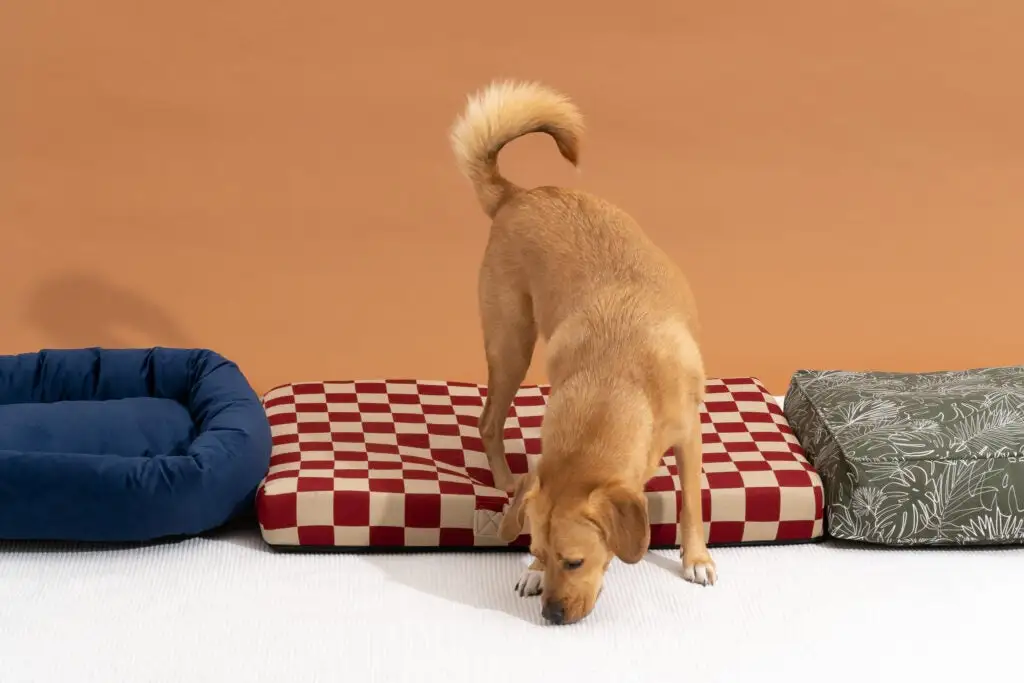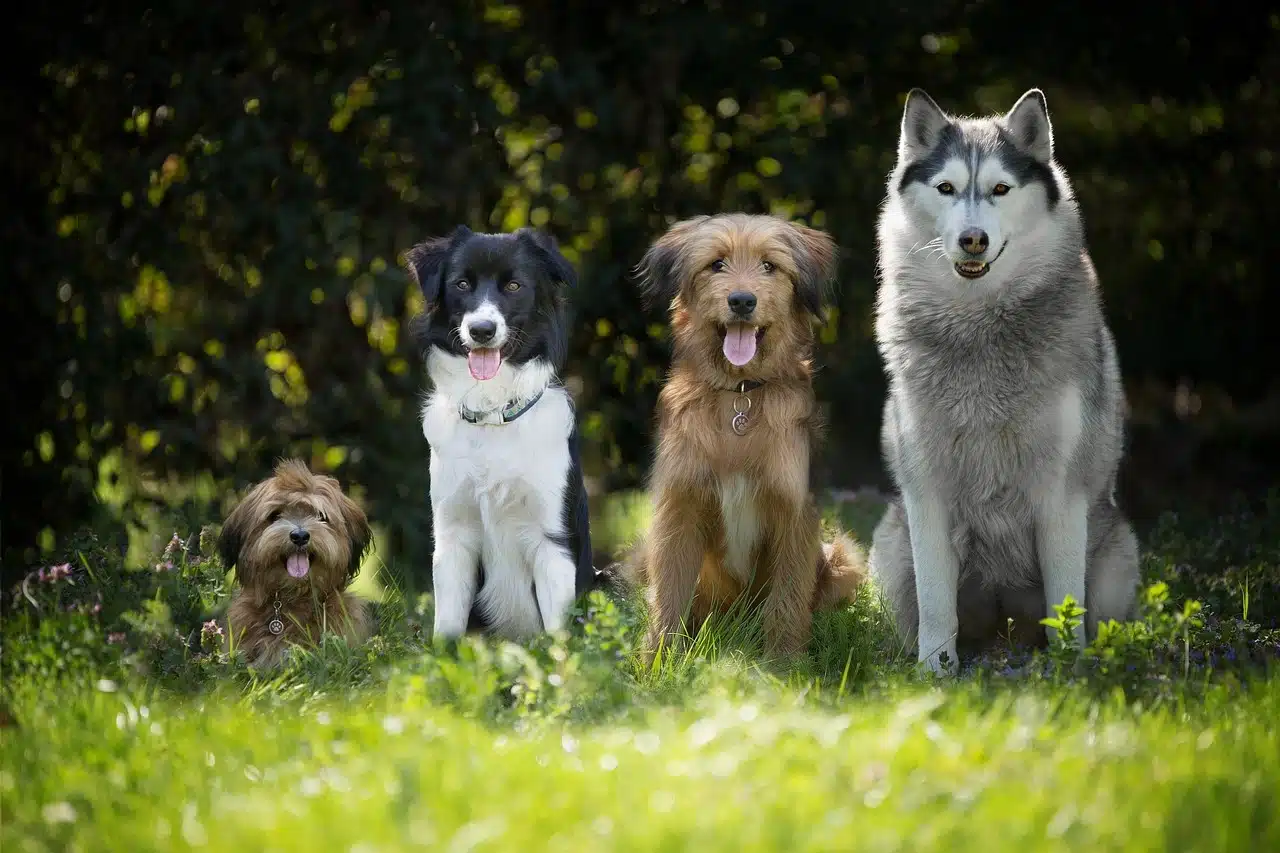Walking through the dog park, you notice the variety of collars—from basic nylon to stylish leather, simple to tech-loaded. Your own pup’s collar is fraying at the edges, and you wonder which dog collar would work best for your four-legged friend. With thousands of options available, finding the right one can feel overwhelming.
Quick Answer
A dog collar is an essential accessory that secures identification, facilitates leash attachment for walks, and can include features like reflective strips or GPS tracking for safety. The ideal fit allows exactly two flat fingers between the collar and your dog’s neck to prevent both escape and pressure injuries.
TL;DR: Choose a collar that’s appropriate for your dog’s size, breed, and activity level. Ensure a proper fit (two-finger rule) and select materials that suit both function and comfort.

Table of Contents
Why the Right Dog Collar Matters
Choosing the appropriate dog collar isn’t just about aesthetics—it directly impacts your pet’s health, safety, and comfort. An ill-fitting collar can cause:
- Skin irritation and hair loss around the neck
- Restricted breathing if too tight
- Trachea damage, especially in small breeds
- Escape risks if too loose
- Neck strain from heavy attachments
Many veterinarians report preventable collar injuries when fit is ignored—especially in small breeds—underscoring the two-finger rule. The right collar supports training, keeps identification secure, and ensures comfortable walks without distress or health risks.
Beyond physical comfort, the proper dog collar contributes to better training results. When dogs associate their collar with positive experiences rather than discomfort, they’re more receptive to leash training and commands during walks.
The Anatomy of a Dog Collar
Understanding collar components helps you make an informed choice for your furry friend:
Materials:
- Nylon/polyester: Lightweight, water-resistant, and available in countless colors
- Leather: Durable, develops patina over time, classic appearance
- Biothane: Waterproof alternative to leather that doesn’t absorb odors
- Chain: Durable but primarily for specific training purposes
- Neoprene: Soft, quick-drying, and ideal for water-loving dogs
Closure Mechanisms:
- Buckle: Traditional, adjustable, secure
- Quick-release: Easy on/off with plastic clips
- Martingale: Limited-slip design for narrow-headed breeds
- Snap: One-handed operation, convenient for daily use
Features to Consider:
- D-ring placement: Where leashes and tags attach
- Padding: Extra comfort around contact points
- Reflective elements: Visibility during evening walks
- Width: Broader collars distribute pressure more evenly
The collar’s width matters significantly. For small breeds, a narrower collar (½-¾ inch) works well, while medium to large dogs benefit from wider collars (1-1½ inches) that distribute pressure more evenly across the neck.
For ID best practices, see the AAHA microchip & ID recommendations for faster reunions with lost pets.
Tools & Product Recommendations
Ruffwear Flat Out Dog Collar
This adventure-ready collar features an aluminum V-ring for leash attachment and a separate ID tag attachment point to reduce jingling. The Tubelok™ webbing maintains its strength even when wet or muddy, making it perfect for outdoor enthusiasts with active dogs. The quick-release buckle makes putting it on and removing it effortless, though some users note the vibrant colors may fade after frequent exposure to sun and water.
Ruffwear Flat Out Dog Collar On Amazon.
GoTags Personalized Dog Collar
Ideal for dogs who frequently lose tags or owners who dislike the constant jingling. This nylon collar comes with embroidered personalization of your contact information directly on the collar. The reflective threading enhances nighttime visibility, and it’s adjustable for growing puppies. While the embroidery is durable and won’t wear off like printed options, the collar itself is standard quality and may not stand up to extreme chewers or very active dogs.
GoTags Personalized Dog Collar On Amazon.
Lupine Eco Dog Collar
Environmentally conscious pet parents will appreciate this collar made from recycled plastic bottles. The Lupine Eco collar offers impressive durability despite its eco-friendly construction, with bar-tack stitching at stress points and a rust-proof buckle. The collar comes with a lifetime guarantee—even if chewed. The only drawback is its slightly stiffer feel when new, though it softens with use. For dogs with sensitive skin, the recycled material has proven less irritating than some synthetic options.
Lupine Eco Dog Collar On Amazon..
PetSafe Gentle Leader Headcollar
While technically not a traditional collar, this headcollar deserves mention for dogs who pull excessively. The nose loop design works with your dog’s natural instincts to reduce pulling without causing pain or choking. It’s particularly effective for large, strong breeds that are difficult to walk using standard collars. The padded noseband ensures comfort, though there is an adjustment period where dogs may initially paw at it. Training resources are included to help your dog accept the headcollar.
PetSafe Gentle Leader Headcollar On Amazon.
Step-by-Step Tutorial: Finding the Perfect Dog Collar
Follow these steps to select, fit, and maintain the ideal collar for your canine companion:
- Measure your dog’s neck Use a soft measuring tape to measure around the middle of your dog’s neck. Add 1-2 inches for small dogs or 2-3 inches for larger breeds to ensure comfort.
- Determine the appropriate width Smaller breeds need narrower collars (½-¾ inch), while medium to large dogs benefit from wider options (1-1½ inches) that distribute pressure.
- Select material based on lifestyle Consider your dog’s activities and sensitivities. If your dog swims often, choose waterproof materials (e.g., Biothane). Dogs with sensitive skin might do better with padded neoprene or soft leather.
- Choose closure type For everyday use, quick-release buckles offer convenience. For escape artists, a traditional buckle might be more secure. Martingale collars work well for narrow-headed breeds like Greyhounds.
- Test the fit Check the fit using the two-finger rule: you should be able to slip two fingers between the collar and your dog’s neck—no more, no less.
- Monitor and adjust Check the fit regularly, especially for growing puppies or dogs that gain/lose weight. Adjust as needed to maintain proper fit.
- Clean regularly Nylon collars can be hand-washed with mild soap and air-dried. Leather requires specific leather cleaners and conditioners to prevent cracking and maintain suppleness.
If you’re struggling with a puppy who’s resistant to collar training, check out our guide on puppy behavior problems for helpful solutions.
Collar Types: Quick Comparison
Flat Collars
Pros:
- Versatile for everyday use
- Available in countless styles, materials, and prices
- Comfortable for most dogs
- Good for ID tags and basic walking
Cons:
- Provides little control for pullers
- Can cause tracheal damage if dog pulls strongly
- May slip off narrow-headed breeds
Best for: Everyday wear, well-behaved dogs, and secure ID attachment
Martingale Collars
Pros:
- Prevents escape for narrow-headed breeds
- Gentler than choke chains
- Available in various materials
- Limited tightening prevents choking
Cons:
- Requires proper adjustment
- Can catch on objects if loose
- Not recommended for tie-out or unsupervised use
Best for: Sighthounds, dogs with narrow heads, and mild pullers
Rolled Collars
Pros:
- Prevents coat breakage for long-haired breeds
- Reduced matting around neck
- Lightweight and less noticeable
- Often made of soft leather
Cons:
- Limited width options
- Less visible than flat collars
- Fewer style options
- Can be more expensive
Best for: Long-haired breeds, dogs with coat matting issues, and show dogs
Training Collars
Pros:
- Provides more control for difficult dogs
- Can reduce pulling behavior
- Some types redirect attention rather than using force
Cons:
- Requires proper training to use correctly
- May cause discomfort if misused
- Some types controversial among trainers
Best for: Specific training scenarios with professional guidance
Use only under guidance from a certified trainer (CPDT-KA); never for all-day wear. The American Veterinary Society of Animal Behavior provides detailed position statements on various training methods and equipment.
For dogs that pull excessively, you might want to explore specialized equipment in our best leash for dogs that pull guide.
Breed & Weight Sizing Guide
Small (up to 25 lbs)
- Chihuahuas, Yorkshire Terriers, Maltese, Miniature Dachshunds
- Collar width: ½-¾ inch
- Neck size typically 8-14 inches
Medium (25-50 lbs)
- Beagles, Cocker Spaniels, Bulldogs, Border Collies
- Collar width: ¾-1 inch
- Neck size typically 14-18 inches
Large (50-80 lbs)
- Labrador Retrievers, Golden Retrievers, Boxers, Pit Bulls
- Collar width: 1-1½ inches
- Neck size typically 18-24 inches
Extra Large (80+ lbs)
- Great Danes, Mastiffs, Newfoundlands, Saint Bernards
- Collar width: 1½-2 inches
- Neck size typically 22-30+ inches
Common Mistakes (and Fixes)
Too tight collar. The fix: Apply the two-finger rule—you should be able to slip two fingers between the collar and your dog’s neck.
Wrong width for breed size. The fix: Choose wider collars for larger breeds to distribute pressure more evenly and prevent injury.
Leaving collars on 24/7 unsupervised. The fix: Remove collars when dogs are in crates or playing with other dogs to prevent catching or choking hazards.
Collar safety during playdates. The fix: Remove collars during playdates to prevent snagging teeth or tags.
Using a collar for pulling dogs. The fix: Switch to a front-clip harness or head collar for dogs who pull consistently to protect their trachea.
Improper ID information. The fix: Include your cell phone number and consider adding “Needs Medication” for dogs with health conditions to ensure urgency if found.
Choosing style over function. The fix: Prioritize proper fit and appropriate design for your dog’s needs before considering purely aesthetic features.
Troubleshooting (If/Then)
If your dog has hair loss around the neck, then try a rolled collar to reduce friction or check for material allergies.
If your dog constantly pulls despite training, then consider a front-clip harness or head collar instead of a standard collar.
If your small dog coughs while pulling on a collar, then switch to a harness to protect their delicate trachea. If the coughing persists, read our article on why is my dog coughing for additional guidance.
If your collar gets wet frequently, then choose waterproof materials like biothane or quick-drying neoprene to prevent skin irritation.
If your dog can back out of their collar, then try a properly fitted martingale collar or harness with back-up safety features.
When to See a Professional
While most collar issues can be resolved at home, certain situations warrant professional attention:
- Persistent skin irritation, rashes, or wounds around the neck area
- Respiratory difficulties potentially related to collar pressure
- Behavioral problems like extreme pulling or collar aggression
- Difficulty finding a collar that fits properly for dogs with unusual neck proportions
According to the American Veterinary Medical Association, certain collar-related issues can indicate underlying health problems. If your dog develops a sudden sensitivity to their previously comfortable collar, consult your veterinarian to rule out neck injuries or skin conditions.
For severe behavioral issues like leash reactivity, a certified professional dog trainer can provide specialized training methods and collar recommendations tailored to your dog’s specific needs.
FAQs
How often should I replace my dog’s collar?
Inspect your dog’s collar monthly for signs of wear including fraying, cracking, or stretched holes. Most quality collars should be replaced every 1-2 years with normal use, though active or outdoor dogs may need more frequent replacements.
Can puppies wear regular dog collars?
Puppies can wear lightweight collars appropriate for their size, but check the fit weekly as they grow. Many puppy owners prefer adjustable collars with room to expand or breakaway collars for safety.
Are retractable leashes safe to use with collars?
Retractable leashes aren’t recommended with standard collars due to potential neck injuries from sudden stops. If you use a retractable leash, pair it with a properly fitted harness instead of a collar.
Should dogs wear collars while at home?
It’s safer to remove collars when dogs are unsupervised, in crates, or playing with other dogs to prevent catching on furniture or during play. For crate training tips, see our guide on puppy whining in crate solutions.
How do I clean different types of dog collars?
Nylon/polyester collars can be hand-washed with mild soap and air-dried. Leather collars should be wiped clean with a damp cloth and treated with leather conditioner. Biothane and neoprene can be cleaned with soap and water.
Are shock or prong collars humane options for training?
The American Kennel Club notes these tools remain controversial. Most positive reinforcement trainers recommend exploring more humane alternatives first, like front-clip harnesses or head collars, combined with consistent training.
What information should be on my dog’s ID tag?
At minimum, include your cell phone number. Consider adding your address, a secondary contact number, and any critical medical information. Avoid putting your dog’s name on public-facing tags as it may make them more trusting of strangers.
Conclusion
Finding the perfect dog collar balances practicality, comfort, and safety for your unique canine companion. By understanding the various options available and how they suit different breeds and situations, you can make an informed choice that enhances your daily walks and keeps your dog secure.
Remember that your dog’s needs may change over time—a growing puppy, a senior dog with arthritis, or a newly adopted rescue with special requirements might all benefit from different collar styles. Regularly reassess your dog’s collar fit and condition as part of responsible pet care.
The best collar is one that works seamlessly with your lifestyle while keeping your dog comfortable and secure. Whether you choose a simple nylon flat collar or invest in a specialized training tool, the right collar strengthens the bond between you and your four-legged friend on every adventure you share.

